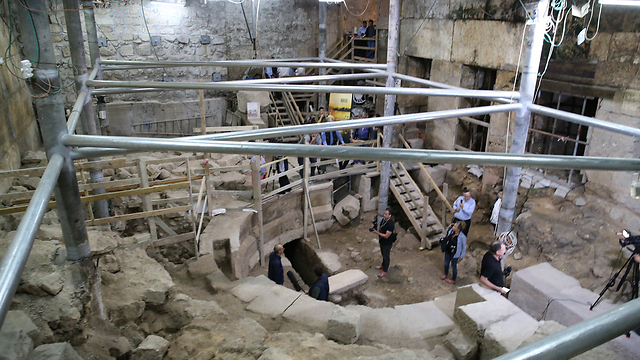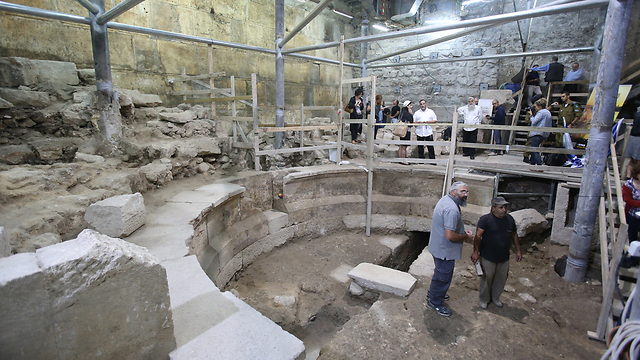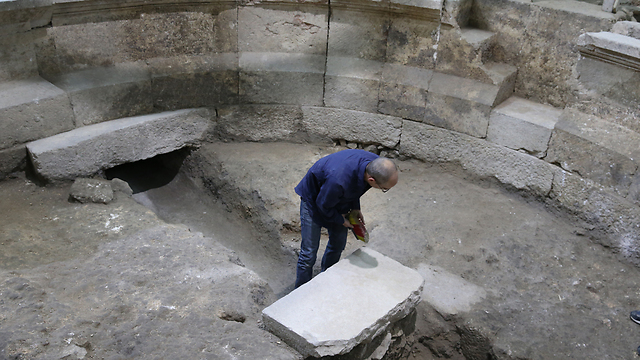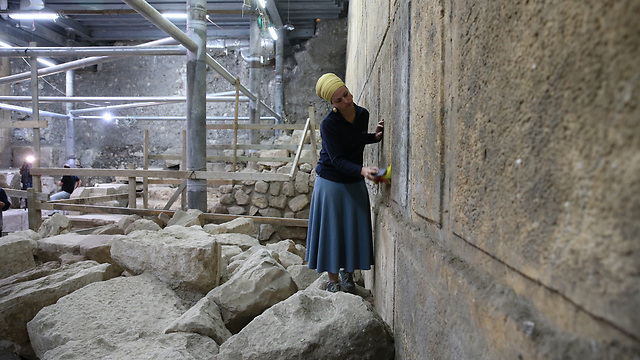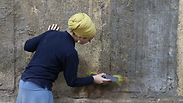
Parts of Western Wall, ancient Roman theater uncovered
Archeologists discover large stone courses of the Western Wall and a large Roman theater-like structure dating back to the Second Temple period—a surprising finding they are calling an archeological 'sensation.'
After uncovering large sections of the Western Wall that have been hidden for 1,700 years, archeologists discover an ancient Roman theater-like structure—shedding light on life in the city after it was razed by the Romans.
Eight completely preserved stone courses from the Western Wall, built of massive stones and of outstanding construction quality, were unearthed under a layer of earth about eight meters thick under Wilson’s Arch— the only intact, visible structure remaining from the Temple Mount compound from the Second Temple period.
After removing a thick layer of soil, archeologists were surprised to uncover what they believe to be an ancient, unfinished theater-like structure from the Roman period—confirming historical writings that describe a theater near the Temple Mount, found in written sources from the Second Temple period, and in sources from the period following the destruction of the Second Temple, when Jerusalem became the Roman colony of Aelia Capitolina.
The discoveries was presented to the public for the first time at a conference entitled "New Studies in the Archaeology of Jerusalem and its Environs," held Monday in Jerusalem, marking 50 years of archaeological research since the city's unification.
Referring to the theater's discovery, site excavators Dr. Joe Uziel, Tehillah Lieberman and Dr. Avi Solomon said that "from a research perspective, this is a sensational find," adding that "the discovery was a real surprise."
"When we started excavating, our goal was to date Wilson’s Arch. We did not imagine that a window would open for us onto the mystery of Jerusalem’s lost theater. Like much of archaeological research, the expectation is that a certain thing will be found, but at the end of the process other findings, surprising and thought-provoking, are unearthed.
"There is no doubt that the exposure of the courses of the Western Wall and the components of Wilson’s Arch are thrilling discoveries that contribute to our understanding of Jerusalem. But the discovery of the theater-like structure is the real drama."
The excavators noted that the theater, which contained approximately 200 seats, "is a relatively small structure compared to known Roman theaters (such as at Caesarea, Bet She’an and Bet Guvrin)."
This fact, in addition to the structure's location under a roofed space, led them to believe that this is either an odeon—used, in most cases, for acoustic performances, or a bouleuterion—the building where the city council met, in this case the council of the roman colony of Aelia Capitolina.
Several findings at the site, such as a staircase that was never completely hewn, led the excavators to deduce that, although great effort was clearly invested in the construction of the theatre, which contained approximately 200 seats, the theatre was never used.
The reason for this is still unknown, but since unfinished structures from the period were already discovered in the Western Wall Plaza, archeologists theorize that it might have to do with a large event that took place at the time, suggesting that it may be due to construction being abandoned when the Bar Kokhba revolt broke out.










